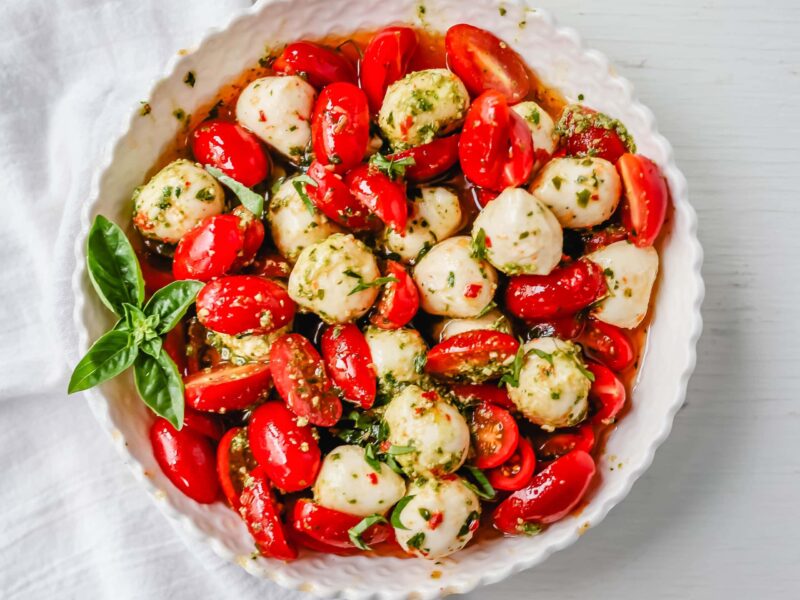Caprese salad is a timeless classic in Italian cuisine, celebrated for its simplicity, freshness, and vibrant flavours. This iconic dish originated on the island of Capri in the Campania region of Italy, where it embodies the essence of Mediterranean culinary traditions.
Composed of just a few key ingredients – ripe tomatoes, fresh mozzarella cheese, basil leaves, extra virgin olive oil, and a sprinkle of salt – Caprese salad exemplifies the beauty of simplicity, allowing each component to shine on its while harmonizing perfectly together. In this exploration, we delve into the history, ingredients, preparation methods, and cultural significance of Caprese salad, a beloved staple on tables around the world.
Historical Origins
The origins of Caprese salad are deeply rooted in the culinary heritage of the Campania region, where fresh and seasonal ingredients reign supreme. Legend has it that the salad was first created in the 1950s at the Trattoria da Vincenzo on the island of Capri. Inspired by the colours of the Italian flag – red, white, and green – the chef, seeking to showcase the island’s abundant produce, combined tomatoes, mozzarella, and basil to create a simple yet visually striking dish. Over time, Caprese salad gained popularity beyond the shores of Capri, becoming a beloved staple in Italian trattorias, pizzerias, and home kitchens.
Key Ingredients
Central to the allure of Caprese salad are its pristine ingredients, each carefully selected for maximum flavour and freshness. Ripe tomatoes, preferably heirloom varieties bursting with sweet, tangy juices, form the foundation of the dish. Sliced into thick rounds or wedges, tomatoes provide a luscious base and a burst of colour.
Fresh mozzarella cheese, traditionally made from buffalo milk, adds a creamy, milky richness to the salad. Sliced or torn into pieces, the mozzarella contrasts beautifully with the tomatoes, creating a symphony of textures.
Fragrant basil leaves plucked from the stem just before serving, infuse the salad with their aromatic essence, adding a peppery, herbaceous note. Extra virgin olive oil, drizzled generously over the salad, ties everything together, enhancing the flavours and imparting a luxurious silkiness. A sprinkle of flaky sea salt, added at the last moment, balances the sweetness of the tomatoes and enhances the overall taste experience.
Preparation Method

The beauty of Caprese salad lies in its simplicity of preparation, requiring minimal effort and expertise. To begin, select the freshest and ripest tomatoes available, preferably from a local farmers’ market or garden. Wash and dry the tomatoes thoroughly before slicing them into uniform rounds or wedges, depending on your preference. Similarly, slice the fresh mozzarella cheese into pieces of similar size to the tomatoes.
Arrange the tomato and mozzarella slices alternately on a serving platter or individual plates, creating an attractive pattern. Tuck fresh basil leaves between the tomato and mozzarella slices, ensuring each bite is infused with the herb’s fragrance. Just before serving, drizzle extra virgin olive oil over the salad, allowing it to pool in the crevices between the tomatoes and mozzarella. Finish with a sprinkle of flaky sea salt and freshly ground black pepper, if desired, to season the salad to perfection.
Cultural Significance
Beyond its culinary appeal, Caprese salad holds cultural significance as a symbol of la dolce vita – the sweet life – in Italy. Its vibrant colours evoke the sun-drenched landscapes of the Mediterranean, while its fresh and seasonal ingredients pay homage to the country’s rich agricultural heritage.
In Italy, Caprese salad is more than just a dish; it is a celebration of simplicity, quality, and the joy of sharing good food with loved ones. Whether enjoyed as a light appetizer, a refreshing side dish, or a standalone meal, Caprese salad embodies the spirit of Italian hospitality, inviting diners to savour the pleasures of the table and embrace life’s simple pleasures.
Variations and Modern Twists
While the traditional Caprese salad remains a beloved classic, chefs and home cooks alike have embraced creativity and innovation, offering a myriad of variations and modern twists on the iconic dish. Some interpretations may feature heirloom tomatoes of different colours and shapes, adding visual interest and complexity to the salad.
Others may incorporate additional ingredients such as grilled vegetables, olives, avocado, or prosciutto, elevating the dish with new flavours and textures. For those seeking a plant-based version, vegan mozzarella cheese made from nuts or tofu can be used as a delicious alternative. Regardless of the variation, the essence of Caprese salad the marriage of ripe tomatoes, fresh mozzarella, basil, and olive oil – remains at the heart of each interpretation, ensuring that every bite is a celebration of Italy’s culinary heritage.
Conclusion
Caprese salad stands as a testament to the timeless appeal of Italian cuisine, where simplicity, quality, and seasonal ingredients take centre stage. From its humble origins on the island of Capri to its status as a global culinary icon, Caprese salad continues to captivate diners with its vibrant colours, fresh flavours, and effortless elegance.
As we savour each bite of ripe tomatoes, creamy mozzarella, and fragrant basil, let us celebrate the beauty of simplicity and the joy of sharing good food with those we love. Whether enjoyed on a sun-drenched terrace overlooking the Mediterranean or at a cosy kitchen table halfway around the world, Caprese salad reminds us that life’s greatest pleasures can be found in the simplest of dishes.










